Geography Class 12 Important Questions Chapter 18 Manufacturing Industries
1 Mark Questions
Question 1.
Name the two rivers that provide water to Tata Iron and Steel Company (TISCO). (Delhi 2013)
Answer:
River Swamarekha and river Kharkai provide water to Tata Iron and Steel Company.
Question 2.
Which sector of the economy accounted for the highest percentage of India’s total value of exports in 2003-2004. (Delhi 2011)
Answer:
Manufacturing or industrial sector of the economy accounted for the highest percentage of India’s total value of exports in 2003-2004.
Question 3.
Which state of India has the largest number of cotton mills? (Delhi 2011)
Answer:
Tamil Nadu has the largest number of cotton mills.
Question 4.
What was the main reason for establishing the first cotton textile mills in Mumbai? (Delhi 2010)
Answer:
The first modem cotton textile mill was established in Mumbai in 1854 because of several reasons. But the most important reason was the proximity of Mumbai with 1 the cotton producing areas of Gujarat and Maharashtra.
Question 5.
Name the iron and steel plant located in Chhattisgarh. (All India 2010)
Answer:
Iron and steel plant located in Chhattisgarh is Bhilai.
3 Marks Questions
Question 6.
Study the diagram given below, showing the location of an important steel plant of India, and answer the questions that follow (All Indio 2017, Delhi 2014)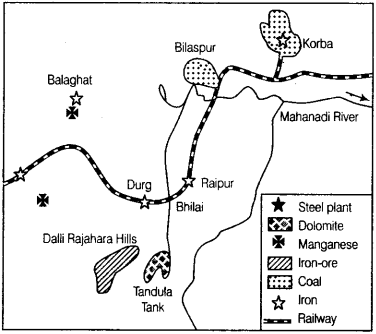
(i) Identify the steel plant and name it.
(ii) Mention the thermal power plant which supplies power to it.
(iii) Mention the source of water for this plant.
Answer:
(i) The steel plant in the above figure is the Bhilai Steel Plant.
(ii) Korba thermal power plant supplies power to it.
(iii) The source of water for this plant is Tandula Tank.
Question 7.
Study the following diagram and answer the questions that follow.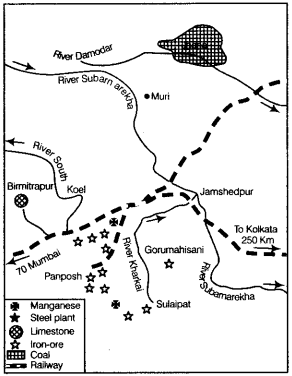
(i) Identify and name the steel plant shown in this diagram
(ii) Name of mining fields which supply coal and limestone to this plant.
(iii) Mention the source of water for this plant. (Delhi 2016)
OR
(i) Identify this steel plant and write its name.
(ii) Name the source of limestone of this plant.
(iii) What is the source of coal for this plant? (Delhi 2012)
Answer:
(i) The plant shown in this diagram is Tata Iron and Steel Plant (TISCO).
(ii) Coal is supplied by Jharia coal fields and limestone is supplied by Birmitrapur mine.
(iii) The source of water for TISCO are:
- Subarnarekha river
- Kharkai river
OR
(i) Steel plant shown in the diagram is Tata Iron and Steel Plant (TISCO).
(ii) Limestone is supplied by Birmitrapur mine to this plant.
(iii) Coal is supplied by Jharia coal fields.
Question 8.
Study the diagram given below and answer the questions that follow. (AH India 2016, 2014)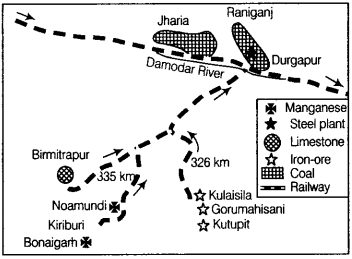
(i) Identify and name the steel plant shown in the diagrams
(ii) Name the mining areas which supply coal and manganese to this plant, (AH Indio 2016)
OR
Name two coal fields which supply coal to this plant. (All India 2014)
(iii) Which is the source of water supply to this plant? (All indin 2016)
Answer:
(i) The steel plant shown in this diagram is the Durgapur Steel Plant.
(ii) Coal mining areas are Raniganj and Jharia. Manganese mining areas are Noamundi and Bonaigarh.
(iii) River Damodar is the source of water supply for this plant.
Question 9.
Explain the role of power and raw material in the location of heavy industries in India. (Delhi 2013)
Answer:
Power location of industries is influenced by the power supply. The power supply should be ensured before locating the industry as it renders the motive force for machines. Some industries like aluminium and synthetic nitrogen manufacturing industries are power intensive and hence should be located near the source of power.
The location of industrial enterprises is sometimes determined simply by the location of the raw materials. Industries using weight losing raw materials are usually located near the supply of the raw materials.
Question 10.
Explain the role of ‘Market’ and ‘Transport’ in the location of industries. (Delhi 2013)
Answer:
The market is the place where the manufactured products are sold. Market-oriented industries like a heavy machine, machine tools, heavy chemicals are located in the region of high demand. Industries like the cotton textile industry which uses a non-weight losing raw material are generally located in large urban centres.
Transport it play a major role in the location of industries i.e. the reason for the location of all major industrial plants on the trunk rail routes.
Question 11.
Explain any three locational factors which helped in the development of Gujarat Industrial Region, (AH Indio 2013)
Answer:
The locational factors which helped the development of Gujarat industrial region are as follows:
- The region corresponds to the cotton growing tracts of the Gujarat plains.
- The discovery of oil fields led to the establishment of petrochemical industries around Ankleshwar, Vadodara and Jamnagar.
- This region became an important textile region with the decline of cotton textile industry in Mumbai.
- Kandla port also helped in the rapid growth of this region.
Question 12.
Explain the significance of the iron and steel industry of India giving three points. (All Indio 2012)
Answer:
Following point explain the significance of iron and steel industry:
- The iron and steel industry provides basic infrastructure to almost all sectors of the Indian Industry.
- The iron and steel industry boosted industrial development in India.
- The iron and steel industry in India provides employment opportunity and hence improve the living standard of people.
Question 13.
Study the diagram showing the location of a major steel plant of India given below and answer the questions that follow.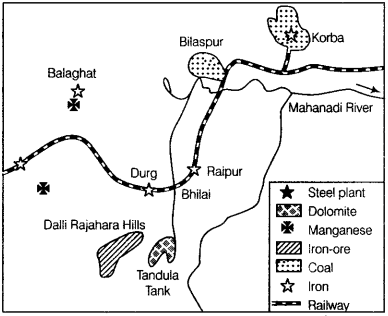
(i) Identify and name the steel plant.
(ii) In which state of India is this plant located?
(iii) Name the source of iron-ore for this plant. (All Indio 2012)
Answer:
(i) The steel plant in the above figure is Bhilai steel plant.
(ii) It is located in the state of Chhattisgarh.
(iii) The source of iron-ore for this plant is Dalli Rajahara Hills.
Question 14.
Explain why are the iron and steel plants located near the source of raw materials in India. (All India 2012)
Answer:
The iron and steel industry uses raw materials which lose weight in the process of manufacture, hence these industries are located near the source of raw material.
Iron-ore and coal both lose their weight during the process of manufacturing of steel, hence they are located near the supply of raw materials. This is the reason for the location of most of iron and steel industries near coalfields or near source of iron-ore.
Question 15.
Explain any three major objectives of the new Industrial Policy of India which was announced in 1991. (Delhi 2011)
Answer:
The three major objectives of the new Industrial Policy of India are as follows:
Abolition of Industrial Licensing
In a major move to liberalise the economy, the new industrial policy abolished all industrial licensing irrespective of the level of investment except for certain industries related to security and strategic concerns and social reasons.
Abolition of Phased Manufacturing Programmes
Devaluation of currency and increasing FDI led the government to liberalise local content requirement for indigenous firms.
Free Entry to Foreign Investment and Technology
The government is committed to promote increased flow of FDI for better technology, modernisation, exports and for providing products and services of international standards.
Question 16.
Analyse any three locational factors which helped in the development of Hugli industrial region.
OR
Explain any three factors which have helped in the development of Hugli industrial Region. (All India 2008)
Answer:
The locational factors which helped in the development of Hugli industrial region are as follows:
- The river Hugli offered the best site for the development of an inland river port as nucleus for the development of Hugh industrial region.
- The discovery of coal and iron-ore in Chotanagpur plateau, tea plantations in Assam and Northern parts of West Bengal and the processing of deltaic Bengal jute led to the industrial development in this region.
- Cheap labour could be found easily from the thickly populated states of Odisha, Bihar, Jharkhand and Eastern part of Uttar Pradesh.
Question 17.
Explain any three factors responsible for the development of Mumbai-Pune industrial region. (All Indio 2008)
Answer:
Three factors which are responsible for the development of Mumbai-Pune industrial region are as following:
- The growth of this industrial region is fully connected with the growth of cotton textile industry in Mumbai.
- Opening of the Suez Canal in 1869 provided impetus to the growth of Mumbai port. The machineries were imported through this port.
- Hydro-electricity was developed in the Western Ghat region to meet the requirements of this industry.
- Opening of the Mumbai High petroleum field and erection of nuclear energy plants added additional pull to this region.
Question 18.
Explain any three factors responsible for the development of the Bangalore-Chennai industrial region. (All India 2008)
Answer:
Three factors responsible for the development of the Bangalore-Chennai industrial region are:
- This region is a cotton growing tract and is dominated by the cotton textile industry.
- Its development was also dependent on the Pykara hydro-electric plant which was built in 1932.
- Cheap skilled labour and proximity to a vast local market as well as good climate have also favoured the concentration of industries in this region.
5 Marks Questions
Question 19.
Mention any four major objectives of the New Industrial Policy, 1991 of India. Describe the role of globalisation in achieving these objectives. (All India 2017)
Answer:
New Industrial Policy, 1991 of India has the following objectives:
- Correct the distortions of weaknesses that have crept in.
- Maintain a sustained growth in productivity and gainful employment.
- Attain international competitiveness.
The role of globalisation in achieving these objectives are:
- Opening the economy to foreign direct investment.
- Removing restrictions and obstacles to the entry of multi-national companies in India.
- Allowing Indian companies to enter into foreign collaboration in India.
Question 20.
Why do large scale industries choose different locations? Explain any four factors which influence the industrial location. (AH India 2017)
OR
Explain with examples any five geographical factors that affect location of an industry at a particular place in India. (All Indio 2011)
OR
Describe any five factors with examples which affect the location of industries in particular region of India. (Delhi 2008)
Answer:
Many important factors involved in the location of individual industries are of relative significance, e.g. availability of raw materials, power resources, water labour, markets and the transport facilities.
Following five geographical factors affect the location of an industry at a particular place in India:
Raw Materials The location of industrial enterprises is sometimes determined simple by location of the raw materials, e.g. industries like iron and steel, which uses weight losing raw materials are located near the source of raw materials. This is the reason for the location of most of the iron and steel industries near the coalfields, (e.g. Bokaro, Durgapur) or near source of iron-ore (e.g. Bhadravati, Bhilai and Rourkela).
Power Power supply should be ensured before locating the industry. It renders to motive force for machines. Some industries like synthetic nitrogen and aluminium and power intensive are hence should be located near to source of power.
Market It is the place where manufactured products are sold. Market oriented industries like heavy machines, machine tools, heavy chemicals are located in the region of high demand, e.g. Koyali, Mathura and Barauni.
Transport It plays a major role in the location of industries. This is the reason for the location of all major industrial plants on the trunk rail routes.
Labour Industries require skilled labour. In India, labour is quite mobile and is available in large number.
Map Based Questions
Question 21.
Locate and label the following features with appropriate symbols on the given outline political map of India.
(i) The integrated iron and steel plant located in Chhattisgarh. (AH Indio 2016)
OR
An integrated iron and steel plant in Chhattisgarh. (Delhi 2014)
(ii) An integrated iron and steel plant in Odisha. (All indin 2015)
(iii) A software technology Park located in Himachal Pradesh. (Delhi 2012)
Answer: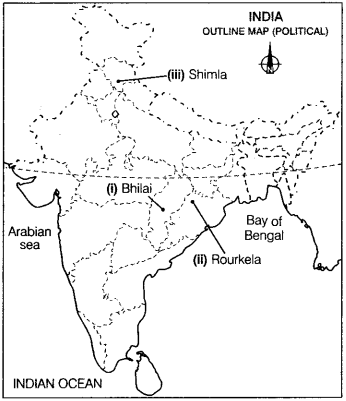
Question 22.
On the given political outline map of India, locate and label the following with appropriate symbols.
(i) The software technology park located in Jammu and Kashmir state. (All India 2010)
(ii) The software technology park located in Madhya Pradesh. (Delhi 2010)
Answer: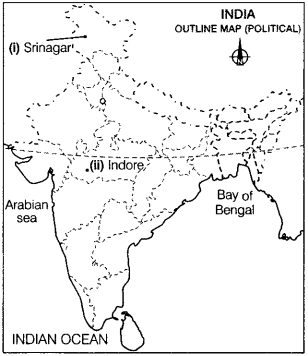
Question 23.
On the given political outline map of India, locate and label the following with appropriate symbols.
(i) Iron and steel plant located in Karnataka state. (All India 2009)
Answer: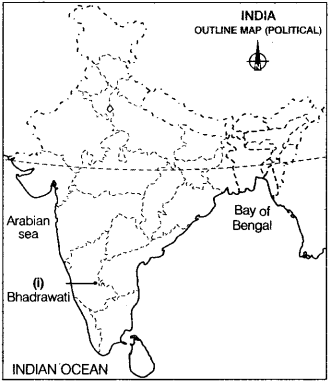
Question 24.
On the given political outline map of India provided to you, locate and label the following with appropriate symbols.
(i) The software technology park in Gujarat state. (Delhi 2008)
(ii) The software technology park of Andhra Pradesh. (All India 2008)
Answer: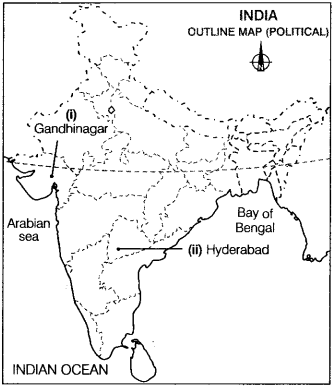
Value Based Questions
Question 25.
“Colonial influence like competition from the British goods and the British discriminatory policies are also important reasons for the emergence of same of our industrial nodes”. Which values of British lead to the emergence of some industrial nodes?
Answer:
Following values of British lead to emergence of industrial nodes:
- Exploitation
- Colonialism
- Discrimination
Question 26.
Globalisation aimed at increasing domestic and external competition through market mechanism and facilitating dynamic relationship with the foreign investor” Which value of globalisation help in increasing competition?
Answer:
Following values increase competition:
- Economic competition
- Market competition
- Profit Making











